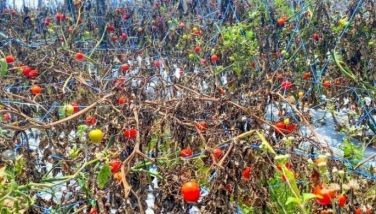PDRRMO assessing inputs to warrant declaration
State of calamity
CEBU, Philippines — The weak El Niño has slowly manifested crippling effects to Cebu’s water supply, fishery production, forestry, and river basins.
According to the data gathered by the Provincial Disaster Risk Reduction Management Office (PDRRMO) in Cebu, several communities and localities have been experiencing low water production, less fish catch, dead seedlings, and subsiding river flow.
As to the water utilities, the data indicated that the Metro Cebu Water District has reduced its production from 33,000 cubic meters to 24,500 cubic meters in Mananga Dam affecting some areas under its franchise due to low water pressure.
The population also in Bogo City is affected with its water district experiencing low water production while the San Remegio Water Service and Sanitation Cooperative observed that the levels of their water wells have reduced to almost two meters.
These three water utilities have undertook rationing of their supply. The Philippine Spring Water Resources Inc. also reported that its water supply has decreased by 15 to 20 percent.
In the fishery sector, the crown-of-thorns starfish, a large species that preys upon hard, or stony, coral polyps, have spread through the sea bottom. PDRRMO data showed that an outbreak of such species have occurred in Cordova, Moalboal, and Dalaguete.
The PDRRMO noted that the prolonged warm ocean temperature will result to the increase of population of these species; the longer these large starfishes are present in the reef, the bigger are the damages.
Cordova also noted fish kills of the bangus aquaculture livestock. Aside from that, fishermen from Cordova and the other two towns, Ginatilan and Dumanjug, have observed a significant decrease in fish catch.
In woodlands and plantations, newly-planted seedlings in some National Greening Program sites have not survived such as in Talisay City, Minglanilla, and Toledo City while the coffee plantations in Tuburan, Tabuelan, San Remegio, and Carmen are also affected.
While in Liloan, Alcoy, Badian, Malabuyoc, and Alcantara, some young plants have wilted, dried shrubs in some towns caught fire, and leaves of some trees have withered in mountain barangays and forestlands.
Among Cebu’s river system, at least 11 rivers in the province have slowly subsided or weakened such as in Naghalin River in Catmon (40 percent decrease); Danao River (5 percent); Caridad-Bakyawan River in Tuburan (100 percent drop in the downstream and 70 percent in the upstream); Putat River in Tuburan (10 percent); Langoyon River in Tuburan (50 percent); Gimamaa River in Tuburan (50 percent); Combado River in Balamban (40 to 50 percent); Guinabasan River in Asturias (50 percent); Bawo River in Sogod (50 percent); Sogod rivers in barangays Ibabao, Nahus-an, Cabangahan and Ampongol (50 percent); and Naga River (50 percent).
PDRRMO Chief Baltazar Tribunalo Jr. said the council members are set to meet today to discuss about the initial findings of the adverse impacts of the El Niño to Cebu before they will decide whether the council will recommend of placing the province under a state of calamity.
“Pero among i-substantiate ang findings ugma (today) para mahimo siyang posibli nga basehan nato para maka declare ta’g state of calamity,” he told reporters on Monday.
If the state of calamity will be declared, the local government units can immediately utilize the Quick Response Fund. He said the province alone has an available P60 million QRF.
Tribunalo said Cebu is under state of preparedness, which was earlier declared by the council. He added the council is asking Cebu Governor Hilario Davide III to draft an executive order so as to make clear directives and guidelines.
“Ang importante lang gyud nga nay order, at the same time naa na may findings, mga initial findings nga kanang ang atoang mga farms, mga mag-uuma, mangingisda apektohan na gyud sa dry spell ba,” he said.
Tribunalo said that the crops that were planted by farmers cannot be of any use anymore.
“Ang katong ilahang natanom niadtong a few months ago, na lawos gyud na sila, so lawos, ug ang farm nang liki na,” he said.
“Ni ubos gyud kaayo ang tubig, water level labi na sa mga high ridge, mga ridges… so, dili na sila kapananom,” he said.
Moreover, water levels on water streams and wells are also rapidly dropping which could also affect the farmers, Tribunalo said.
“Ang atong water level sa mga sapa moubos na siya so atong mga wells kilid sa sapa sa mga plain area, mu ubos pud na. So, ang mga farmer nga naa sa kapatagan wa na pud silay ma harvest,” he said.
“Mao na ang problema, kay tungod sa kainit sa tubig, ang dagat ana perti nang inita and mga isda di na magpamabaw adto na sila sa lawom,” he said. — Tanja Catherine R. Stöckli (FREEMAN)
- Latest



























